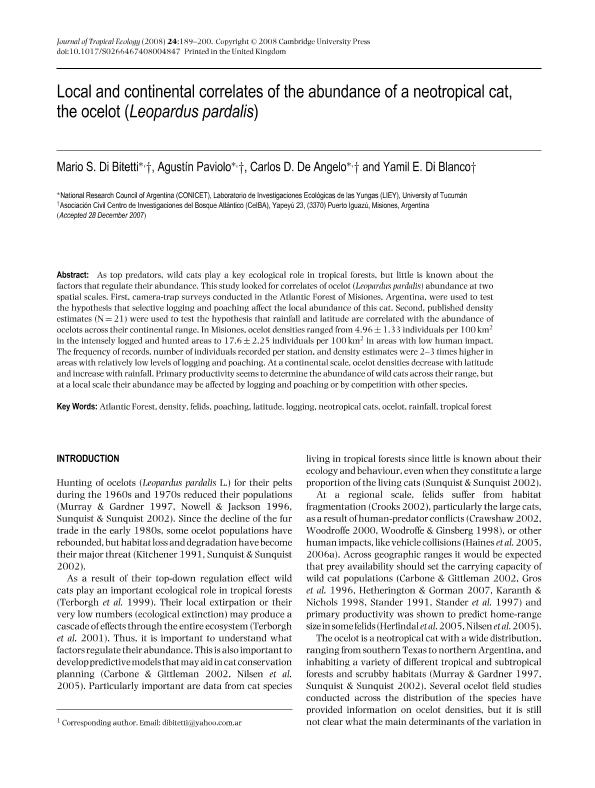Mostrar el registro sencillo del ítem
dc.contributor.author
Di Bitetti, Mario Santiago

dc.contributor.author
Paviolo, Agustin Javier

dc.contributor.author
de Angelo, Carlos Daniel

dc.contributor.author
Di Blanco, Yamil Edgardo

dc.date.available
2018-09-28T18:57:48Z
dc.date.issued
2008-03
dc.identifier.citation
Di Bitetti, Mario Santiago; Paviolo, Agustin Javier; de Angelo, Carlos Daniel; Di Blanco, Yamil Edgardo; Local and continental correlates of the abundance of a neotropical cat, the ocelot (Leopardus pardalis); Cambridge University Press; Journal Of Tropical Ecology; 24; 2; 3-2008; 189-200
dc.identifier.issn
0266-4674
dc.identifier.uri
http://hdl.handle.net/11336/61267
dc.description.abstract
As top predators, wild cats play a key ecological role in tropical forests, but little is known about the factors that regulate their abundance. This study looked for correlates of ocelot (Leopardus pardalis) abundance at two spatial scales. First, camera-trap surveys conducted in the Atlantic Forest of Misiones, Argentina, were used to test the hypothesis that selective logging and poaching affect the local abundance of this cat. Second, published density estimates (N = 21) were used to test the hypothesis that rainfall and latitude are correlated with the abundance of ocelots across their continental range. In Misiones, ocelot densities ranged from 4.96 ± 1.33 individuals per 100 km 2 in the intensely logged and hunted areas to 17.6 ± 2.25 individuals per 100 km2 in areas with low human impact. The frequency of records, number of individuals recorded per station, and density estimates were 2-3 times higher in areas with relatively low levels of logging and poaching. At a continental scale, ocelot densities decrease with latitude and increase with rainfall. Primary productivity seems to determine the abundance of wild cats across their range, but at a local scale their abundance may be affected by logging and poaching or by competition with other species. © 2008 Cambridge University Press.
dc.format
application/pdf
dc.language.iso
eng
dc.publisher
Cambridge University Press

dc.rights
info:eu-repo/semantics/openAccess
dc.rights.uri
https://creativecommons.org/licenses/by-nc-sa/2.5/ar/
dc.subject
Atlantic Forest
dc.subject
Density
dc.subject
Felids
dc.subject
Latitude
dc.subject
Logging
dc.subject
Neotropical Cats
dc.subject
Ocelot
dc.subject
Poaching
dc.subject
Rainfall
dc.subject
Tropical Forest
dc.subject.classification
Conservación de la Biodiversidad

dc.subject.classification
Ciencias Biológicas

dc.subject.classification
CIENCIAS NATURALES Y EXACTAS

dc.title
Local and continental correlates of the abundance of a neotropical cat, the ocelot (Leopardus pardalis)
dc.type
info:eu-repo/semantics/article
dc.type
info:ar-repo/semantics/artículo
dc.type
info:eu-repo/semantics/publishedVersion
dc.date.updated
2018-09-18T14:07:14Z
dc.journal.volume
24
dc.journal.number
2
dc.journal.pagination
189-200
dc.journal.pais
Reino Unido

dc.journal.ciudad
Cambridge
dc.description.fil
Fil: Di Bitetti, Mario Santiago. Consejo Nacional de Investigaciones Científicas y Técnicas; Argentina. Centro de Investigaciones del Bosque Atlántico; Argentina. Universidad Nacional de Tucumán. Facultad de Ciencias Naturales e Instituto Miguel Lillo. Laboratorio de Investigaciones Ecológicas de las Yungas; Argentina
dc.description.fil
Fil: Paviolo, Agustin Javier. Centro de Investigaciones del Bosque Atlantico, Puerto Iguazu; Argentina. Universidad Nacional de Tucumán. Facultad de Ciencias Naturales e Instituto Miguel Lillo. Laboratorio de Investigaciones Ecológicas de las Yungas; Argentina
dc.description.fil
Fil: de Angelo, Carlos Daniel. Centro de Investigaciones del Bosque Atlantico, Puerto Iguazu; Argentina. Universidad Nacional de Tucumán. Facultad de Ciencias Naturales e Instituto Miguel Lillo. Laboratorio de Investigaciones Ecológicas de las Yungas; Argentina
dc.description.fil
Fil: Di Blanco, Yamil Edgardo. Centro de Investigaciones del Bosque Atlantico, Puerto Iguazu; Argentina. Universidad Nacional de Tucumán. Facultad de Ciencias Naturales e Instituto Miguel Lillo. Laboratorio de Investigaciones Ecológicas de las Yungas; Argentina
dc.journal.title
Journal Of Tropical Ecology

dc.relation.alternativeid
info:eu-repo/semantics/altIdentifier/doi/http://dx.doi.org/10.1017/S0266467408004847
dc.relation.alternativeid
info:eu-repo/semantics/altIdentifier/url/https://www.cambridge.org/core/journals/journal-of-tropical-ecology/article/local-and-continental-correlates-of-the-abundance-of-a-neotropical-cat-the-ocelot-leopardus-pardalis/BDA833D312EFF2153AA878F9A9DFF110
Archivos asociados
